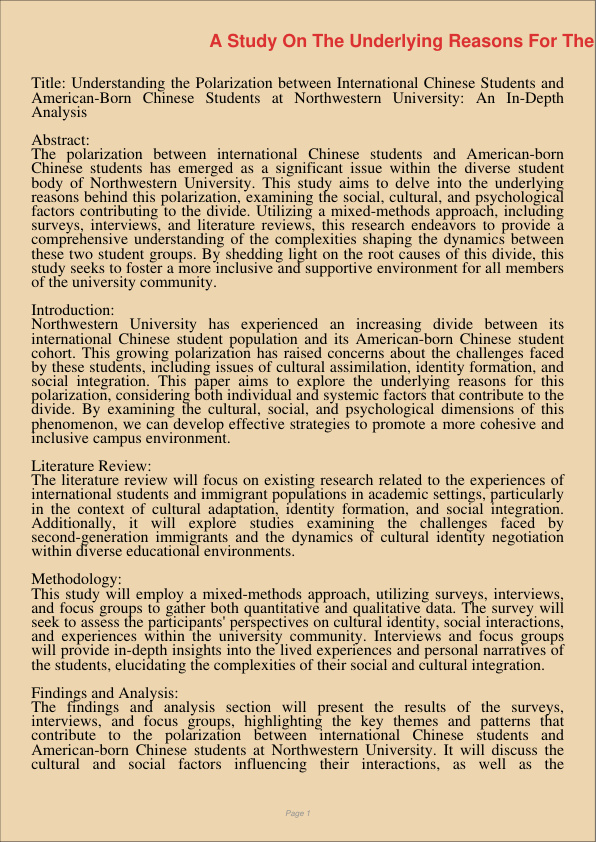A Study On The Underlying Reasons For The Polarization Of International Chinese Students And AmericanBorn Chinese Students At Northwestern University
Jan 9, 2024
international chinese students
born chinese students
Journalism & Communication
Family & Consumer Science
Title: Understanding the Polarization between International Chinese Students and American-Born Chinese Students at Northwestern University: An In-Depth Analysis
Abstract: The polarization between international Chinese students and American-born Chinese students has emerged as a significant issue within the diverse student body of Northwestern University. This study aims to delve into the underlying reasons behind this polarization, examining the social, cultural, and psychological factors contributing to the divide. Utilizing a mixed-methods approach, including surveys, interviews, and literature reviews, this research endeavors to provide a comprehensive understanding of the complexities shaping the dynamics between these two student groups. By shedding light on the root causes of this divide, this study seeks to foster a more inclusive and supportive environment for all members of the university community.
Introduction: Northwestern University has experienced an increasing divide between its international Chinese student population and its American-born Chinese student cohort. This growing polarization has raised concerns about the challenges faced by these students, including issues of cultural assimilation, identity formation, and social integration. This paper aims to explore the underlying reasons for this polarization, considering both individual and systemic factors that contribute to the divide. By examining the cultural, social, and psychological dimensions of this phenomenon, we can develop effective strategies to promote a more cohesive and inclusive campus environment.
Literature Review: The literature review will focus on existing research related to the experiences of international students and immigrant populations in academic settings, particularly in the context of cultural adaptation, identity formation, and social integration. Additionally, it will explore studies examining the challenges faced by second-generation immigrants and the dynamics of cultural identity negotiation within diverse educational environments.
Methodology: This study will employ a mixed-methods approach, utilizing surveys, interviews, and focus groups to gather both quantitative and qualitative data. The survey will seek to assess the participants’ perspectives on cultural identity, social interactions, and experiences within the university community. Interviews and focus groups will provide in-depth insights into the lived experiences and personal narratives of the students, elucidating the complexities of their social and cultural integration.
Findings and Analysis: The findings and analysis section will present the results of the surveys, interviews, and focus groups, highlighting the key themes and patterns that contribute to the polarization between international Chinese students and American-born Chinese students at Northwestern University. It will discuss the cultural and social factors influencing their interactions, as well as the psychological implications of identity negotiation and belonging within the university context.
Discussion: The discussion section will contextualize the findings within the broader sociocultural framework, emphasizing the implications for fostering a more inclusive and supportive campus environment. It will propose practical strategies and recommendations for promoting cross-cultural understanding, fostering intergroup dialogue, and cultivating a sense of belonging among all members of the university community.
Conclusion:
The conclusion will summarize the key findings of the study and emphasize the significance of understanding the underlying reasons for the polarization between international Chinese students and American-born Chinese students at Northwestern University. It will underscore the importance of fostering cultural awareness, promoting intercultural communication, and cultivating a sense of community and belonging within the university environment. Finally, it will highlight avenues for future research and interventions aimed at addressing this polarization and promoting a more inclusive and cohesive campus community.
